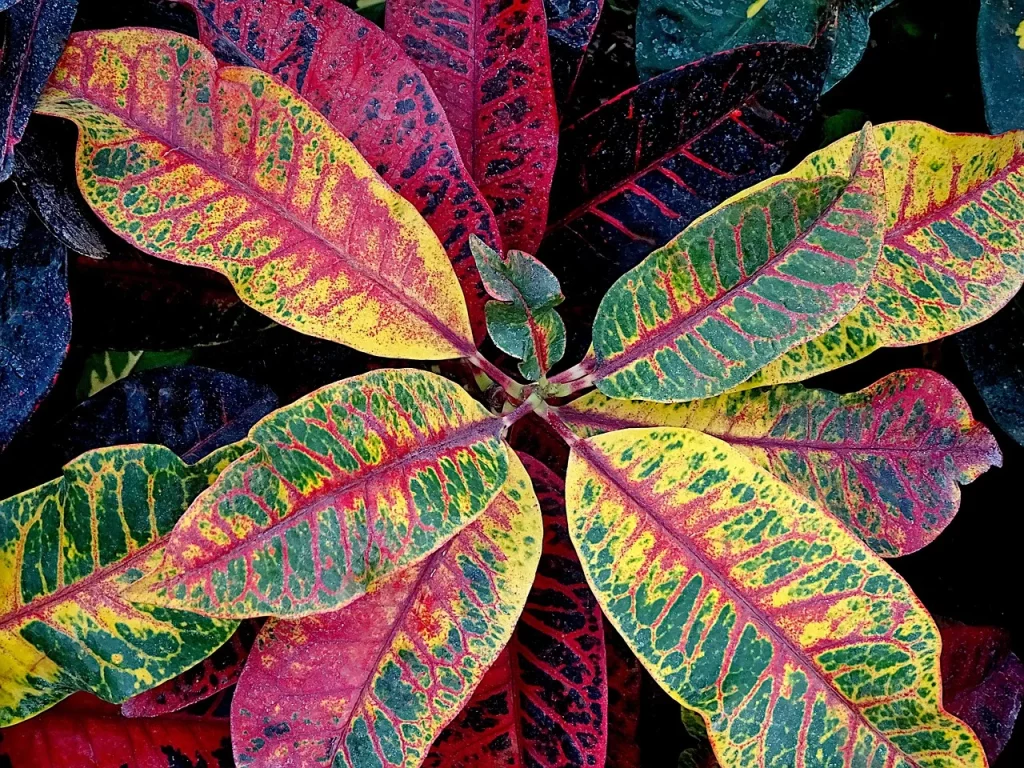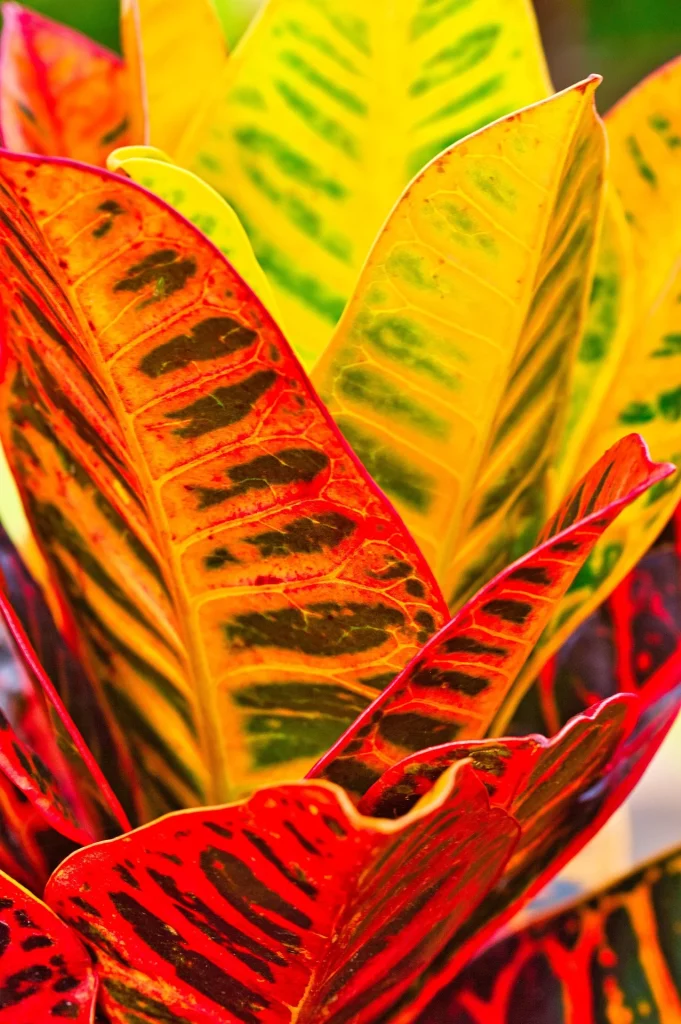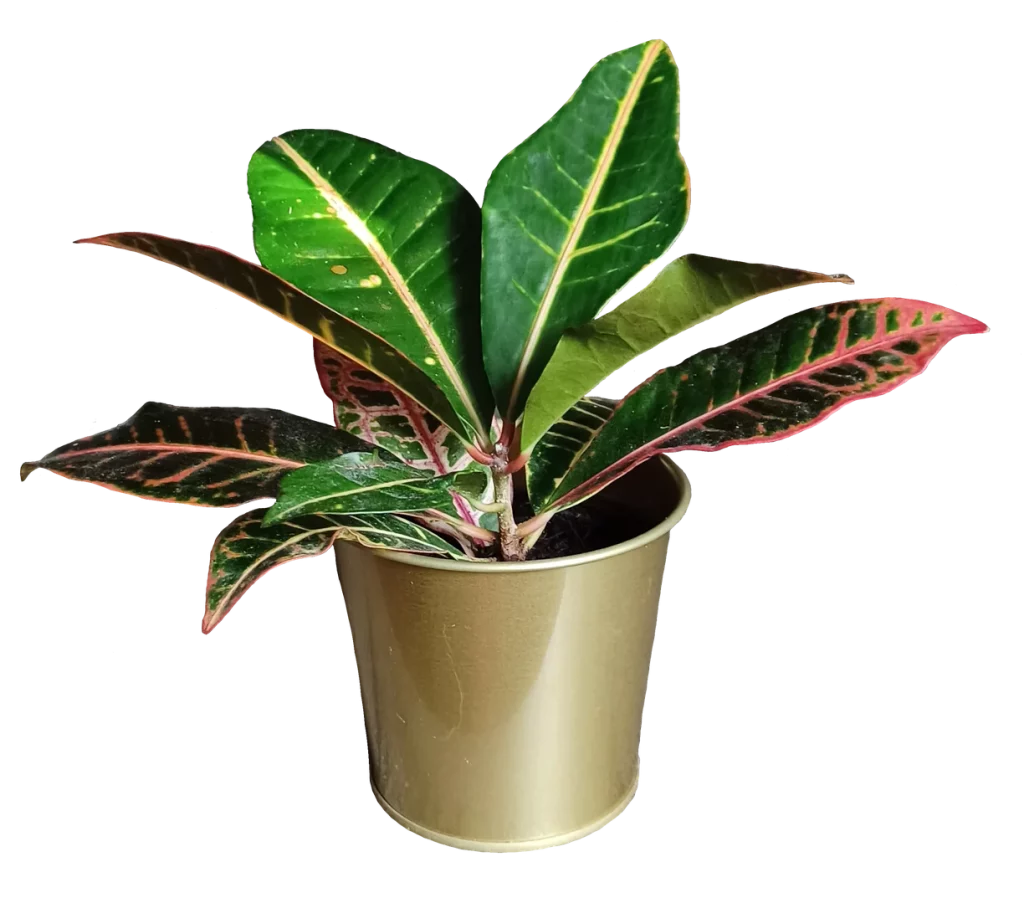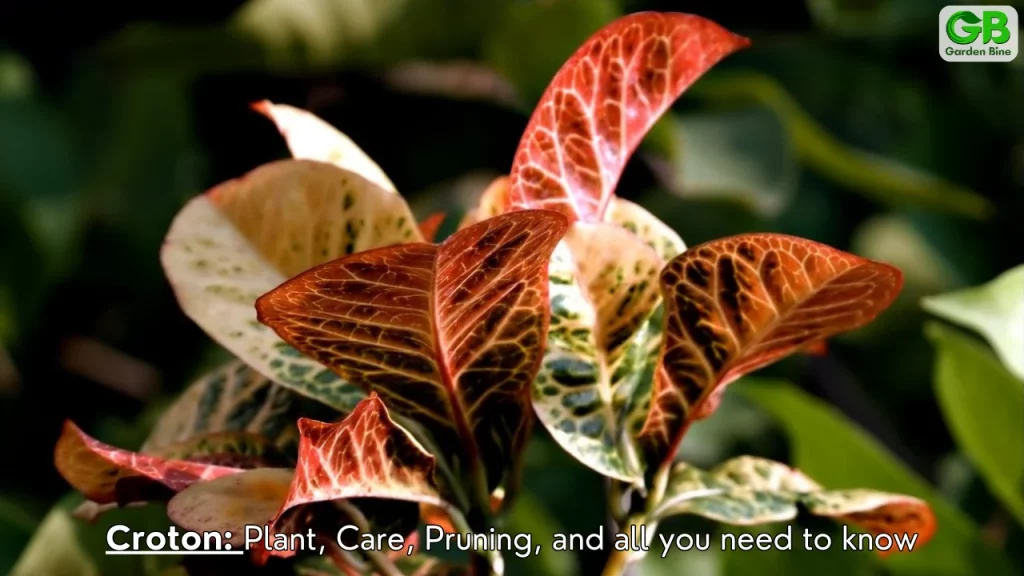Croton plant, (Codiaeum variegatum) is a perennial evergreen shrub. It is native to India and Malaysia, due to which it has the qualities of a tropical plant. It is very popular among people because of its thick, leathery leaves with different colors, shapes, and sizes. Their leaves are very beautiful, due to and they add color to the environment wherever they live (indoors or outdoors). New leaves are of bright color at first, then gradually with age their color becomes darker and starts becoming almost black.
Croton and Rushfoil
It is often asked, ‘Are the Croton plant and Rushfoil the same thing?’ So the answer is, that a special species of Croton plant ‘Croton michauxii’ or ‘Michaux’s croton’ is named rushfoil. The term “Croton” is often used to refer to all the different species within this genus.
Can Croton plants be kept indoors?
It can be planted in pots inside the house in the same way as it is planted outside. There is only one condition, its needs should be fulfilled. Generally, the number of people installing it inside and outside is almost equal. Its main requirements are temperature and humidity. By completing both, you can keep the Croton plant indoors. Without light, the croton’s color will fade. It helps in growth if the temperature is between 50 to 80 degrees Fahrenheit. Make arrangements to place it on your eastern or southern window which gets sunlight so that it gets proper light and illumination. Apart from this, you can install a humidifier or sprinkle water from time to time to meet the humidity requirement.
Why is the Croton plant popular and what are its benefits?

The Croton plant is highly popular among people mainly for the brilliant colors and designs of its leaves. It is adept at adding great texture and color to dull rooms or gardens and that too without flowers. This plant is enough to fill any landscape with different colors and brightness. It also has many other benefits such as medicinal benefits in the form of Croton Tigium oil.
Planting tips for Croton plants
Croton plants are somewhat sensitive to temperature. It will withstand maximum or minimum temperatures only up to a certain limit. Thus, it is important to pay attention to some things before planting them. If the temperature in your area reaches below 50 degrees Fahrenheit at any time throughout the year, you should plant it in a pot. This is because, in extremely cold conditions, you can take it inside the house. Whereas in normal situations it can remain kept outside. On the other hand, if the temperature in your area remains normal and does not reach danger, you are free to plant the croton plant in the soil. For this, the soil should be loose and with good drainage.
While choosing a pot for planting, you should choose one that can handle its increased size. Plant the plant in it with potting mixture. Also, the pot should have holes for proper drainage. Consider placing this plant indoors on a windowsill that gets the best sunlight. Also be sure to protect it from air conditioning vents near windows or any drafts, which can adversely affect it.
Light
Like other plants, Croton plants do not like direct sun. Most of their varieties like bright, indirect light. Both direct sun and very little sunlight have a bad effect on them. The result is that the color of their leaves starts changing and if this happens for a long time, they may even die. In other words, they need dappled sunlight to thrive.
Water
Croton needs good watering during summer. About 1 inch per week. For this, make a rule for watering and follow it. Keep checking the water level from time to time. It is possible that the effect of heat is severe in your area and withering marks may appear on the leaves of your plant. For this, you can check the moisture of the upper soil and keep watering in an appropriate amount. But do not let it get too wet.
Reduce watering a bit in winter. You can observe the leaves to determine whether water is needed or not. If the leaves are moving towards withering, it means they need water.
Soil
Croton prefers acidic, loose, well-drained, moist, and well-enriched soil with compost.
Temperature and Humidity
The biggest problem in growing and keeping Croton plants indoors compared to outdoors is temperature and humidity. Due to the lack of bright light and improper humidity level, the color of its leaves starts changing. Lack of adequate humidity may cause some leaves to die.
If possible, keep the plants near a brightly lit window. Keep the plant away from cold drafts. Indoors, keep the room where you keep croton plants at a temperature of no more than 60 degrees Fahrenheit and a humidity level of 40 to 80 percent. Due to a lack of time or to avoid excessive stress, you can use a humidifier or humidity tray.
Fertilizer
There are many types of fertilizers and they differ from each other. Please read the package instructions for information on how and in what quantity to give. If you can use fertilizer regularly, use a slightly smaller amount of fertilizer than recommended on the package and observe the results at the end of the month. Then increase or decrease the quantity as per your requirement, so that you get the desired results.
If you cannot apply fertilizer continuously, apply slow-release fertilizer preferably three times during the growing season. First in early spring, then in mid-summer, and finally in early fall. Stop fertilizing during the winter months to give them a chance to prepare for the next growing season.
How to care for croton plants
 We plant them for their beautiful leaves. If they are taken proper care of, they help a lot in adding color to the surroundings and making the environment pleasant with their attractive leaves. Many things can be done to care for Croton. Here are some tips…
We plant them for their beautiful leaves. If they are taken proper care of, they help a lot in adding color to the surroundings and making the environment pleasant with their attractive leaves. Many things can be done to care for Croton. Here are some tips…
- It requires even moisture during summer. But after giving water, definitely give it a chance to drink. Next time before watering, check the moisture in the soil so that you can avoid excessive watering. Whereas in winter, less amount of water should be given.
- Croton plants also need a lot of sun to maintain the vibrant color of their leaves. For this, you can keep them on a window where there is good sunlight. For example, on an eastern or southern window, where there is sunlight for several hours a day.
- It likes good humidity. Often maintaining the right humidity environment for this is a challenging task. Low humidity increases the risk of some leaves of the plant falling and also increases the risk of spider mite attack. To avoid all this, sprinkle water around the leaves once or twice a week. Use a humidifier or place a tray of wet gravel near the plant.
- To maintain the beauty and bright colors of the leaves, gently remove the dust from the leaves with a damp cloth once in 15-20 days.
- Continue to fertilize throughout the growing season. While avoiding fertilizing in mid-fall and winter.
- If the croton plant has grown too large for its current pot, wait until the following spring to repot it in a larger pot.
How to Prune a Croton Plant?
Pruning croton plants is an important and beneficial process. By doing this correctly you encourage the plant to produce new growth. This process also helps you keep the plant in the shape and size you want. Here are some tips for sorting…
- The best time for pruning is spring. Since this is the time to encourage new growth, pruning at this time helps the plant compensate for the pruning by growing new parts. However, you can cut off the side stems or leaves at any time as needed.
- Remove unhealthy/dead leaves and branches. If you want to maintain a specific shape, prune accordingly.
- Trim just above a node or leaf set. The plant will grow again from the cut part.
- When pruning, never remove more than one-third (1/3) of the plant. If you have to prune more, first allow the plant to compensate for the pruning, then prune further.
- If pruning an indoor plant, let it harden a bit. Then take out and install. It will take about a week for it to adapt to the external conditions.
- Wear gloves to protect yourself, as this plant produces a milky sap that can irritate your skin if it comes in contact with it. Also, to maintain the beauty and health of the plant, you can clean it with a solution of bleach and water before and after pruning. Which contains 90 percent water and 10 percent bleach. By the way, this is an optional process.
Propagation of Croton Plants
While propagating Croton, some big and small factors have to be kept in mind. Otherwise no problem. Let us see what those factors are…
- Propagating Croton from seeds is not effective, because after propagating from seeds, its color and form change compared to its original form. You don’t know whether it will be exactly like its parents or something different. Therefore propagation by stem cutting is considered the best option.
- Croton is easy to propagate by stem cuttings. For this, take stem cuttings of 4 to 6 inches. Remove its lower leaves. Then put the stalk in a glass of clean water. After some time its roots will emerge. Then plant it in a pot. The cutting remembers its characteristics and takes the shape of a new plant, encouraging new growth.
- If the temperature is favorable, you can propagate croton plants at any time throughout the year. Favorable here means a temperature between 70 to 80 degrees Fahrenheit. If such temperatures prevail in your area, then you can propagate it outside. If this temperature is not maintained outside, then you can maintain this temperature by making a greenhouse inside the house and then propagating it.
- Croton plants sometimes produce shoots called sports. If you want to experiment with growing Croton plants with new colors, you can replant them. But keep in mind that they will be different from their parents and maybe favorable or unfavorable to your expectations.
Potting and Repotting Croton Plants

Since the size of steam cuttings is quite small, a small pot is chosen for planting for the first time. Here he develops very fast. Therefore, it is advisable to repot it in the first three years. You should only choose spring or early summer time for replanting. Further, if you see its roots coming out to the soil level or from the bottom of the pot, then only think about replanting.
To repot Croton plants in pots, you have to take a pot slightly larger than the current one with good drainage. Then set the plant in moist peat-based potting soil and cover it thoroughly with soil. Then water thoroughly.
How to care for croton plants in the winter? (Overwintering)
Croton is used to living in hot temperatures and cannot tolerate freezing temperatures. It can survive a sudden cold snap, but will not be able to withstand sustained cold weather. Therefore you will have to take some measures.
If you have them outside in a pot, bring them indoors as soon as temperatures drop below 50 degrees Fahrenheit and place them on a well-lit windowsill. Besides, it also requires a humid environment. For which you can use a humidifier or spray it yourself.
If you planted outside in soil, add about two to three inches of mulch around the base of the plant to protect it. Also, use a gardener’s blanket to protect from frost and maintain warmth. Use a sturdy stick to anchor the blanket so it doesn’t fall on leaves and branches. Also, take measures to protect the blanket from being blown away by the wind.
Common pests and plant diseases
It is sensitive to some diseases and pests. Keep inspecting it from time to time and also take necessary measures. Here some common pests and diseases that trouble plants are being explained.
- Croton plants are plagued by common houseplant pests such as mealybugs, spider mites, thrips, and scale insects. Use insecticides, horticultural oil, or insecticidal soap to remove these pests.
- Leaf spot or leaf blight is a fungal infection that causes brown spots on the leaves. Or it is also contagious. Remove infected leaves as soon as possible.
- The crown gall is a bacterial infection that causes thick, swollen growths to appear on croton stems and the veins of its leaves. It can spread to other plants and cause considerable damage. If you see this disease in your plant, throw away the plant along with the pot and disinfect the gardening tools.
Common Problems with Croton Plants
Croton demands some special environment, in the absence of which it starts showing some signs and is on the verge of dying. Like right temperature and humidity are important for this. On the other hand, cold winds, drop in temperature, insufficient moisture, insufficient nutrients and poor soil will make it unhealthy. Insects will cause harm and make you sick. These seem like very serious problems but it is quite easy to protect your plant from all this. Here are some common problems and their solutions…
Leaf discoloration
The beauty of this plant is due to its leaves. But sometimes the colors of their leaves become dull. Their leaves get their bright color due to good lighting. But sometimes due to high temperatures or heatstroke, the leaves start becoming dull.
If this happens, try to make the temperature suitable for the plant. Provide proper cool airflow. Stop using fertilizer. Check the water level and water it. In some time it will recover and return to its original form.
Curling of leaves
If the leaves grow and roll or curl, then it is a sign that the plant is growing faster than normal and its need for light is not being met. To protect yourself, reduce fertilizer and place it in a bright location.
Fall of leaves
Falling leaves indicate that temperatures are cooler than normal for it or that it is affected by cold winds. It is also possible that it is infested with pests such as mites and mealybugs. Investigate the situation and take necessary measures.
For example, if there is an insect attack, clean the leaves with insecticidal soap or treat the affected areas with horticultural oil. On the other hand, if the temperature is dropping below 50 degrees Fahrenheit, try to maintain it at a temperature of 60 to 80 degrees Fahrenheit. Improvement will be visible soon.
FAQs
Is the Croton plant poisonous?
This plant does not fall in the category of most poisonous varieties. But you may have some trouble eating it or its juice, the risk of which should not be taken. If it is consumed in excess, it can cause many side effects like stomach ache, vomiting, and diarrhea. Whereas the white sap released while pruning the plant can cause irritation and staining if it comes in contact with the skin.
Is Croton deadly to cats?
Croton’s large and colorful leaves can be attractive to cats. If you have both a Croton plant and a cat, keep your plant in a location where the cat cannot easily reach it. The Croton plant is as dangerous for cats as it is for humans. If you notice your cat’s behavior not being normal and suspect that he has eaten a croton plant, take him to the vet.
How tall does a Croton plant grow?
Many varieties of Croton exist, some of which are dwarf, while others can grow up to ten feet tall. Its average height is about three feet. Its average varieties are more popular because a plant with large leaves looks beautiful in a pot and adds color to the environment.
Do Croton plants flower?
When mature, croton plants produce much smaller bulb-like, less attractive flowers. These don’t seem very important. The beauty of this plant lies in its big and gorgeous leaves.
Also read:



